The research, which had the support of the Gentera company, is based on the generation of 16 indicators with an annual frequency from 2005 to 2022, as well as 14 related gender gaps, with which it was possible to point out progress and challenges in the workplace. Mexican.
Based on the National Institute of Geography and Statistics (Inegi), the gender gaps take the number 1 as a reference, which implies equality between men and women.
Gender gaps less than 1 show higher data for women, while gaps greater than 1 represent higher data for men.
Among the positive results, the presence of women in senior and middle management has maintained a growing trend in the study period, increasing 10.6 percentage points in the participation of women in this type of position, reaching 38.6%. in 2022.
However, one of the most worrying results is that referring to young women without studying, training or working, since in this indicator the gap is 0.37 in 2022.
“This indicator shows that 26.3% of the total female population group does not study, work or receive training, leaving them at a disadvantage when it comes to entering the labor market,” said Yvette Mucharraz y Cano, director of CIMAD.
In addition, he specified, the gap in the employment-population ratio for 2022 is 1.73, which means that men enter the labor market more frequently than women.
Informality, days and precariousness
Regarding informal work, the study reveals that women tend to integrate more in this sector, with a gap of 0.965 by 2022, almost equal to 0.969 in 2005.
Regarding working poverty, both women and men present similar figures, which yields a gap of 0.99 in 2022.
However, there is also a slight difference between low-paid women and men, with a gap of 0.972.
On the other hand, job insecurity, which refers to the lack of job security and stability derived from the contractual situation of workers, is similar between men and women.
Their gender gap is 1.08; while payment for work disability is slightly more frequent in women, which is represented by a gap of 0.93, similar to that of social security coverage, with 0.95.
Finally, it stands out that men tend to suffer excessive working hours more frequently, represented by a gap of 1.65.
However, men have more free time than women, which is expressed in a gap of 1.1, which represents approximately 8 hours more free time on average for men by 2022.
Benjamín Alemán Castilla, professor in the area of Economic Environment at IPADE, affirmed that “it is necessary to focus on reducing labor poverty and working to reduce the number of young people without studying.”













